Q. Redirected to Checkload.net. When I browse the Web on my web browser, it redirects to unwanted web page named Checkload.net. What can I do to stop this from happening? Does anyone else have this issue? What can I do to rectify this? I’m operating on Windows 10 if that helps for solving this issue.
A. Sounds like some kind of adware on your PC. Most probably, one of the programs you installed came with adware (also known as ‘ad-supported’ software). What is the purpose of Adware? Adware software can cause many troubles such as undesired advertisements and pop-ups on your web-browser, redirect your search requests to advertising web-pages, browser crashes and slow loading web-pages. Adware often installs on the PC system with the free applications.
The worst is, adware be able to collect lots of user information such as what websites you are opening, what you are looking for the World Wide Web and so on. This user data, afterwards, may be used for marketing purposes.
Usually, adware software gets into your PC as part of a bundle with freeware, sharing files and other unsafe programs which you downloaded from the Web. The makers of adware pays software makers for distributing adware within their programs. So, additional programs is often included as part of the installer. In order to avoid the installation of any adware: choose only Manual, Custom or Advanced setup method and reject all additional apps in which you are unsure.
Threat Summary
| Name | Checkload.net |
| Type | adware, PUP (potentially unwanted program), redirect virus, pop ups, pop-up ads, pop up virus |
| Symptoms |
|
| Removal | Checkload.net removal guide |
You probably want to know how to remove adware software as well as remove Checkload.net redirect. In the steps below we will tell you about how to solve your issues.
How to remove Checkload.net redirect from Chrome, Firefox, IE, Edge
Not all unwanted apps like adware software responsible for Checkload.net redirect are easily uninstallable. You might see pop-ups, deals, text links, in-text ads, banners and other type of ads in the Chrome, MS Edge, Firefox and Internet Explorer and might not be able to figure out the application responsible for this activity. The reason for this is that many unwanted software neither appear in MS Windows Control Panel. Therefore in order to completely get rid of Checkload.net redirect, you need to use the following steps. Some of the steps below will require you to shut down this website. So, please read the few simple steps carefully, after that bookmark or print it for later reference.
To remove Checkload.net redirect, perform the following steps:
- Manual Checkload.net redirect removal
- How to remove Checkload.net redirect automatically
- Run AdBlocker to block Checkload.net and stay safe online
- To sum up
Manual Checkload.net redirect removal
To remove Checkload.net redirect, adware and other unwanted applications you can try to do so manually. Unfortunately some of the adware software won’t show up in your application list, but some adware may. In this case, you may be able to get rid of it via the uninstall function of your computer. You can do this by following the steps below.
Uninstall recently added adware
It’s of primary importance to first identify and remove all potentially unwanted applications, adware software programs and hijacker infections through ‘Add/Remove Programs’ (Windows XP) or ‘Uninstall a program’ (Windows 10, 8, 7) section of your Microsoft Windows Control Panel.
Windows 8, 8.1, 10
First, click the Windows button
Windows XP, Vista, 7
First, click “Start” and select “Control Panel”.
It will show the Windows Control Panel like below.

Next, click “Uninstall a program” ![]()
It will open a list of all programs installed on your system. Scroll through the all list, and uninstall any suspicious and unknown apps. To quickly find the latest installed apps, we recommend sort applications by date in the Control panel.
Remove Checkload.net redirect from Google Chrome
Run the Reset internet browser tool of the Chrome to reset all its settings to original defaults. This is a very useful utility to use, in the case of browser redirects to intrusive web pages such as Checkload.net.
First launch the Chrome. Next, press the button in the form of three horizontal dots (![]() ).
).
It will open the Google Chrome menu. Choose More Tools, then press Extensions. Carefully browse through the list of installed extensions. If the list has the extension signed with “Installed by enterprise policy” or “Installed by your administrator”, then complete the following guide: Remove Google Chrome extensions installed by enterprise policy.
Open the Chrome menu once again. Further, click the option called “Settings”.

The browser will open the settings screen. Another solution to show the Google Chrome’s settings – type chrome://settings in the web-browser adress bar and press Enter
Scroll down to the bottom of the page and click the “Advanced” link. Now scroll down until the “Reset” section is visible, as displayed on the screen below and click the “Reset settings to their original defaults” button.

The Google Chrome will display the confirmation dialog box like below.

You need to confirm your action, click the “Reset” button. The browser will launch the procedure of cleaning. When it’s finished, the browser’s settings including home page, default search provider and new tab page back to the values which have been when the Chrome was first installed on your system.
Remove Checkload.net from Firefox by resetting browser settings
If Firefox settings are hijacked by the adware, your browser shows undesired pop up ads, then ‘Reset Mozilla Firefox’ could solve these problems. Essential information like bookmarks, browsing history, passwords, cookies, auto-fill data and personal dictionaries will not be removed.
First, start the Mozilla Firefox. Next, click the button in the form of three horizontal stripes (![]() ). It will open the drop-down menu. Next, click the Help button (
). It will open the drop-down menu. Next, click the Help button (![]() ).
).

In the Help menu click the “Troubleshooting Information”. In the upper-right corner of the “Troubleshooting Information” page click on “Refresh Firefox” button as shown on the image below.

Confirm your action, click the “Refresh Firefox”.
Get rid of Checkload.net redirect from Internet Explorer
In order to recover all internet browser homepage, default search engine and newtab you need to reset the IE to the state, which was when the Microsoft Windows was installed on your system.
First, open the Internet Explorer, then click ‘gear’ icon ![]() . It will display the Tools drop-down menu on the right part of the internet browser, then click the “Internet Options” like below.
. It will display the Tools drop-down menu on the right part of the internet browser, then click the “Internet Options” like below.

In the “Internet Options” screen, select the “Advanced” tab, then press the “Reset” button. The Internet Explorer will open the “Reset Internet Explorer settings” dialog box. Further, click the “Delete personal settings” check box to select it. Next, press the “Reset” button like below.

After the task is finished, press “Close” button. Close the IE and restart your personal computer for the changes to take effect. This step will help you to restore your browser’s start page, search engine by default and newtab to default state.
How to remove Checkload.net redirect automatically
The simplest solution to delete Checkload.net redirect is to use an antimalware program capable of detecting this adware that causes Checkload.net redirect in your web browser. We advise try Zemana or another free malware remover which listed below. It has excellent detection rate when it comes to adware, hijackers and other potentially unwanted programs.
Scan and clean your internet browser of Checkload.net redirect with Zemana Anti Malware (ZAM)
Zemana Anti-Malware (ZAM) is a free tool that performs a scan of your computer and displays if there are existing adware, browser hijackers, viruses, worms, spyware, trojans and other malicious software residing on your PC. If malware is detected, Zemana Anti Malware (ZAM) can automatically remove it. Zemana Anti-Malware (ZAM) doesn’t conflict with other antimalware and antivirus programs installed on your computer.
Download Zemana Free by clicking on the link below.
164309 downloads
Author: Zemana Ltd
Category: Security tools
Update: July 16, 2019
Once the downloading process is complete, close all windows on your computer. Further, run the install file called Zemana.AntiMalware.Setup. If the “User Account Control” prompt pops up as on the image below, click the “Yes” button.

It will display the “Setup wizard” which will help you install Zemana AntiMalware (ZAM) on the PC system. Follow the prompts and do not make any changes to default settings.

Once install is complete successfully, Zemana Anti Malware will automatically run and you can see its main window as displayed below.

Next, click the “Scan” button for scanning your machine for the adware that causes Checkload.net redirect in your web-browser. This task may take quite a while, so please be patient. During the scan Zemana Anti Malware will scan for threats present on your machine.

After the system scan is done, Zemana will open a scan report. In order to remove all items, simply click “Next” button.

The Zemana will begin to get rid of adware responsible for Checkload.net redirect. After the procedure is finished, you can be prompted to reboot your PC system.
Scan your computer and remove Checkload.net redirect with Hitman Pro
HitmanPro is a free portable program that scans your machine for adware software which causes Checkload.net redirect, PUPs and hijacker infections and helps get rid of them easily. Moreover, it will also help you get rid of any harmful web-browser extensions and add-ons.
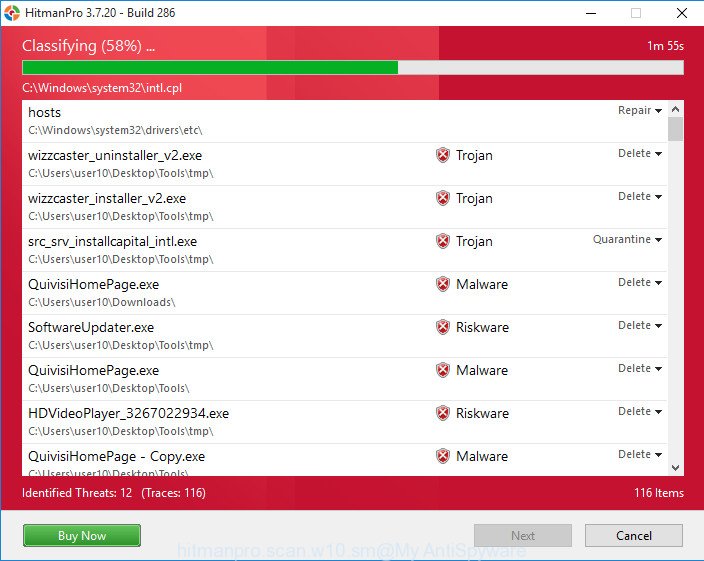
- Installing the Hitman Pro is simple. First you will need to download HitmanPro on your MS Windows Desktop by clicking on the following link.
- When the download is complete, double click the HitmanPro icon. Once this utility is started, press “Next” button for checking your personal computer for the adware that causes Checkload.net redirect. This process can take some time, so please be patient.
- After the scanning is finished, Hitman Pro will prepare a list of undesired applications adware. Review the results once the utility has done the system scan. If you think an entry should not be quarantined, then uncheck it. Otherwise, simply click “Next” button. Now click the “Activate free license” button to start the free 30 days trial to get rid of all malware found.
Scan and clean your computer of adware with MalwareBytes Anti-Malware
We suggest using the MalwareBytes that are fully clean your computer of the adware. The free utility is an advanced malware removal application made by (c) Malwarebytes lab. This program uses the world’s most popular anti-malware technology. It’s able to help you delete unwanted Checkload.net redirect from your browsers, potentially unwanted software, malicious software, hijackers, toolbars, ransomware and other security threats from your computer for free.
Installing the MalwareBytes AntiMalware (MBAM) is simple. First you’ll need to download MalwareBytes from the link below.
326649 downloads
Author: Malwarebytes
Category: Security tools
Update: April 15, 2020
After the downloading process is done, close all applications and windows on your PC. Open a directory in which you saved it. Double-click on the icon that’s named mb3-setup as shown below.
![]()
When the installation starts, you will see the “Setup wizard” which will help you setup Malwarebytes on your PC system.
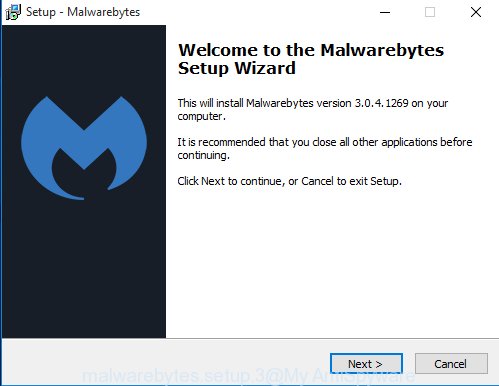
Once installation is finished, you will see window as shown on the screen below.
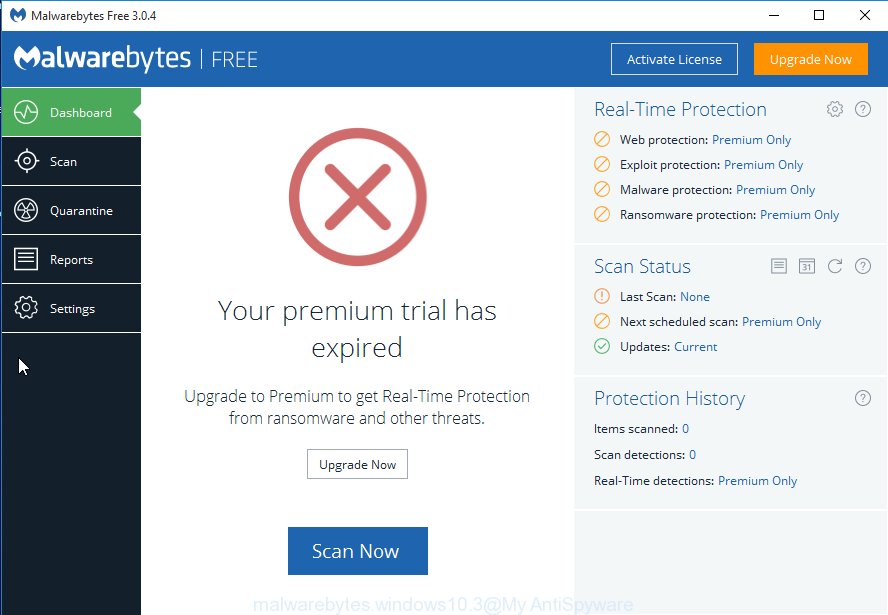
Now click the “Scan Now” button . MalwareBytes Free program will scan through the whole system for the adware that causes Checkload.net redirect. This procedure can take quite a while, so please be patient. During the scan MalwareBytes will search for threats present on your computer.
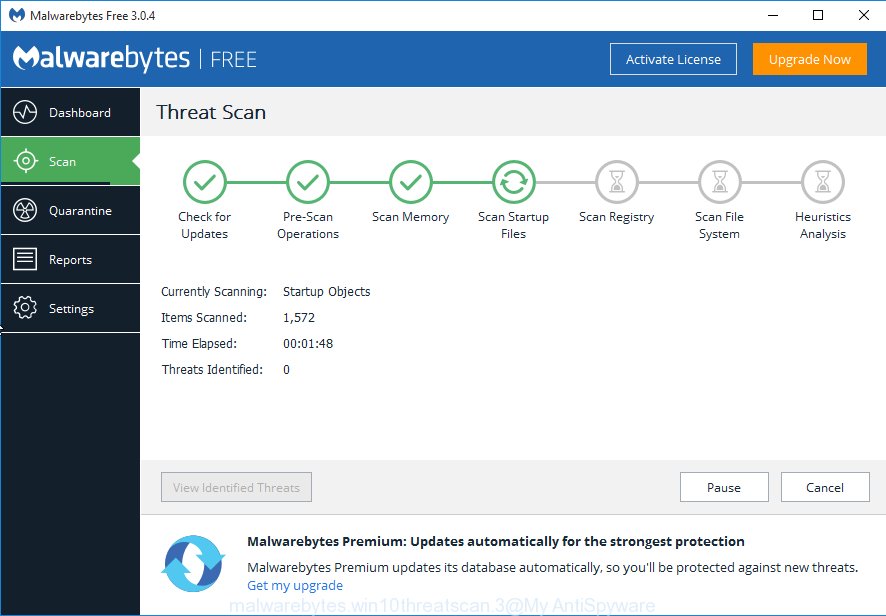
After finished, MalwareBytes Anti Malware (MBAM) will display you the results. Review the report and then click “Quarantine Selected” button.
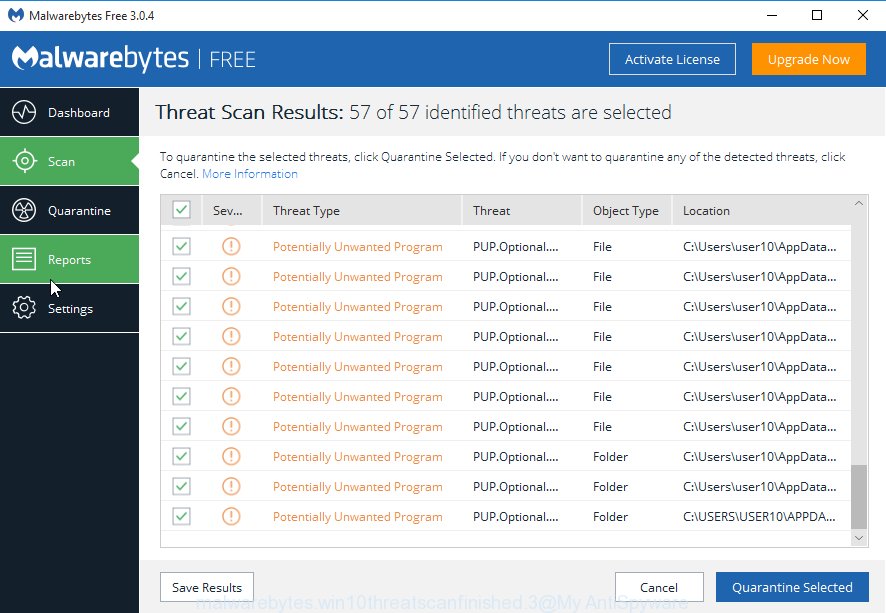
The Malwarebytes will now begin to get rid of adware software responsible for Checkload.net redirect. When disinfection is done, you may be prompted to restart your personal computer.

The following video explains steps on how to delete hijacker, adware and other malicious software with MalwareBytes Anti-Malware (MBAM).
Run AdBlocker to block Checkload.net and stay safe online
In order to increase your security and protect your system against new undesired ads and harmful websites, you need to use adblocker program that stops an access to malicious ads and websites. Moreover, the program may stop the show of intrusive advertising, which also leads to faster loading of web pages and reduce the consumption of web traffic.
AdGuard can be downloaded from the following link. Save it on your Microsoft Windows desktop or in any other place.
26728 downloads
Version: 6.4
Author: © Adguard
Category: Security tools
Update: November 15, 2018
When the downloading process is finished, launch the downloaded file. You will see the “Setup Wizard” screen as displayed in the figure below.

Follow the prompts. Once the installation is finished, you will see a window as shown on the image below.

You can press “Skip” to close the installation program and use the default settings, or click “Get Started” button to see an quick tutorial that will allow you get to know AdGuard better.
In most cases, the default settings are enough and you do not need to change anything. Each time, when you launch your PC system, AdGuard will launch automatically and stop undesired advertisements, block Checkload.net, as well as other harmful or misleading web-sites. For an overview of all the features of the program, or to change its settings you can simply double-click on the AdGuard icon, which is located on your desktop.
To sum up
Now your computer should be free of the adware that causes Checkload.net redirect in your web-browser. We suggest that you keep AdGuard (to help you block unwanted website and unwanted malicious web-pages) and Zemana Free (to periodically scan your personal computer for new adware softwares and other malware). Probably you are running an older version of Java or Adobe Flash Player. This can be a security risk, so download and install the latest version right now.
If you are still having problems while trying to delete Checkload.net redirect from the Microsoft Internet Explorer, Google Chrome, Mozilla Firefox and Edge, then ask for help here here.



















